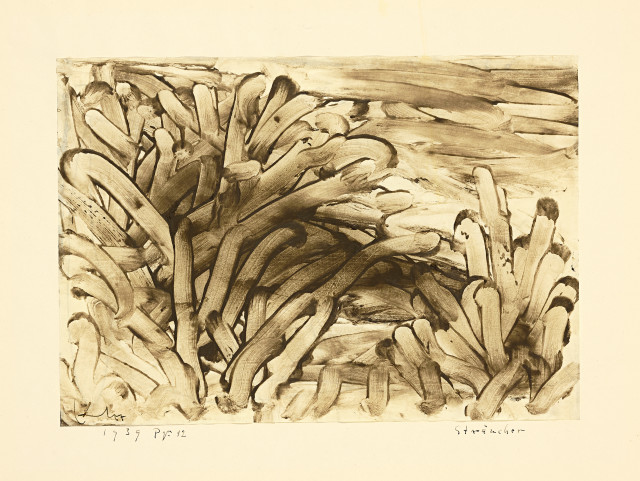- EN
Log in
- Live Auctions
- Past auctions
- More
- Gallery
- Art Dealing
- Publishing
- Kornfeld today
- The Story of Kornfeld
- Information






Münchenbuchsee bei Bern 1879 - 1940 Muralto
1939 - work number 1939.1252 (PQu 12)
Paste colours in dark brown, applied with the fingers, on "Bambou-Japon"
20.7x29.4 cm, image; 35x50 cm, backing board
Signed "Klee" by the artist in pen and brown ink at lower left in the image. Laid down by the artist on backing cardboard, on the backing cardboard on the left in pen and ink with the work number "1939 PQu 12" and on the right with the title "Sträucher". In the lower left corner probably by the artist himself in pencil with two suggested titles "Wildnis" and "Sträucher"
Catalogue raisonné, Paul Klee, vol. 8, Werke 1939, Bern 2004, no. 8959
Collection Hans and Erika Meyer-Benteli, Bern
Auction Galerie Kornfeld, Bern, 21 June 1991, lot 78, from there to
Private collection Switzerland
Matthias Kühn, Gewagte Symbiosen, Bild und Bildtitel im Spätwerk Klees, published in exhibition catalogue: Bern, Museum of Art, Paul Klee, 1990, pag. 93-99
Fresh in colour and in impeccable overall condition
Already marked by his serious illness, Paul Klee continued to work intensively in the last years of his life. Characteristic are the generous formal language, two-dimensional compositions and a reduced colour palette.
Klee also tried out finger painting as a form of expression and planned a series entitled "Wildnis" (Wilderness). A first sheet was created in autumn 1939, "Hartes Gras" (Cat. rais. 8902), probably followed on the same day by two further works, "Schup" and "Schjup" (Cat. rais. 8903 and 8904). A few days later he made "Wildnis / Gestrüpp" (Cat. rais. 8935), which ended with the present sheet towards the end of the year. A final sheet from 1940 takes up the theme again, albeit in a different form of expression, cf. "Wildnis / Drei Bäume" (Wilderness / Three Trees, Cat. rais. 9270).
The work offered here was part of the important collection of Hans and Erika Meyer-Benteli and is one of the outstanding works from the artist's late career.
1939 - Werknummer 1939.1252 (PQu 12)
Kleisterfarben in Dunkelbraun, mit den Fingern aufgetragen, auf "Bambou-Japon"
20,7x29,4 cm, Darstellung; 35x50 cm, Unterlagekarton
Unten links in der Darstellung vom Künstler in Feder in brauner Tinte signiert "Klee". Vom Künstler auf Unterlagekarton aufgelegt, auf dem Unterlagekarton links in Feder in Tinte mit der Werknummer "1939 PQu 12" und rechts mit dem Titel "Sträucher". Unten links in der Ecke wohl eigenhändig in Bleistift mit zwei Titelvorschlägen "Wildnis" und "Sträucher"
Catalogue raisonné, Paul Klee, Band 8, Werke 1939, Bern 2004,
Slg. Hans und Erika Meyer-Benteli, Bern
Auktion Galerie Kornfeld, Bern, 21. Juni 1991, Los 78, von dort an
Privatsammlung Schweiz
Matthias Kühn, Gewagte Symbiosen, Bild und Bildtitel im Spätwerk Klees, erschienen in Ausstellungskatalog: Bern, Kunstmuseum, Paul Klee, 1990, pag. 93-99
Farbfrisch und in tadelloser Gesamterhaltung
Schon von seiner schweren Krankheit gezeichnet, arbeitet Paul Klee in den letzten Lebensjahren intensiv weiter. Charakteristisch sind die grosszügige Formensprache, flächige Kompositionen und eine reduzierte Farbpalette
Klee erprobte auch die Fingermalerei als Ausdrucksform und plante eine Serie mit dem Titel "Wildnis". Ein erstes Blatt entstand im Herbst 1939 "Hartes Gras" (Cat. rais. 8902), wohl am gleichen Tag folgten zwei weitere Arbeiten "Schup" und "Schjup" (Cat. rais. 8903 und 8904). Wenige Tage später entstand "Wildnis / Gestrüpp" (Cat. rais. 8935), um dann gegen Ende des Jahres mit dem vorliegenden Blatt zu enden. Ein letztes Blatt aus dem Jahre 1940 nimmt das Thema wieder auf, wenn auch in veränderter Ausdrucksform, vgl. "Wildnis / Drei Bäume" (Cat. rais. 9270)
Das hier angebotene Werk befand sich in der bedeutenden Sammlung von Hans und Erika Meyer-Benteli und zählt zu den herausragenden Arbeiten aus dem Spätwerk des Künstlers







